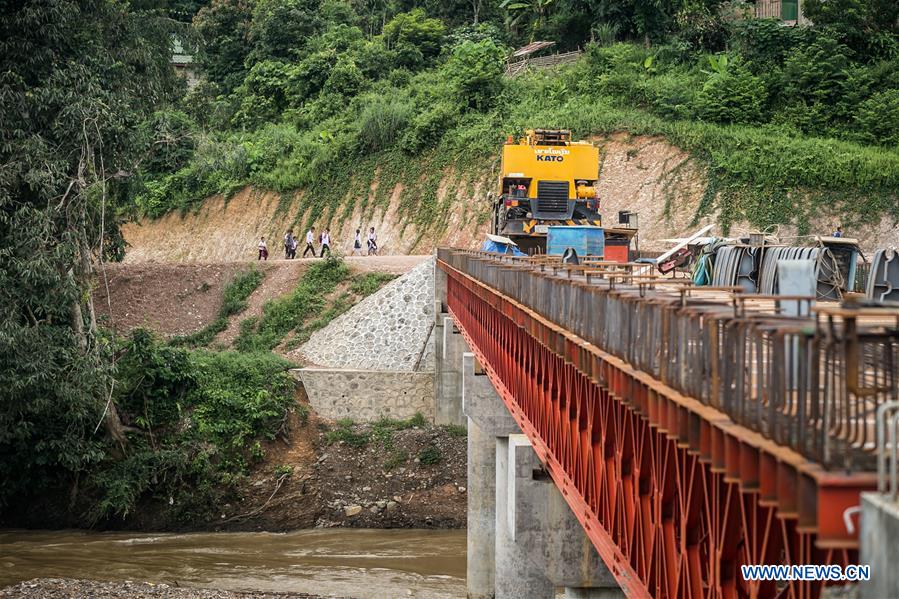China, Laos cooperate to enhance poverty reduction capacity with hard, soft methods
"Learning from to China's poverty reduction experience, we did not simply bring money and project here like blood transfusion, but have been carrying out more effective and sustainable 'hematopoietic poverty alleviation' in the project villages," Fan Xining, a Chinese director told Xinhua in northern Laos' hilly Ban Xor village.
"Learning from to China's poverty reduction experience, we did not simply bring money and project here like blood transfusion, but have been carrying out more effective and sustainable 'hematopoietic poverty alleviation' in the project villages," Fan Xining, a Chinese director told Xinhua in northern Laos' hilly Ban Xor village.

"Hard methods" like building the visible roads, bridges, greenhouses and schools as well as "soft methods" to support the project like training, visits and exchanges were also included, Fan said.
He is leading a team of Chinese experts engaged in a China-Laos joint poverty alleviation project.
Under the pilot project to reduce poverty in East Asia, namely the China-aided Laos Poverty Reduction Demonstration Cooperation Technical Assistance Project, the Chinese team selected Ban Xor village, some two hours' drive on the bumpy roads to the north from Laos' capital Vientiane, and another one in Luang Prabang, to apply China's experience in shaking off poverty since September 2017.
Among the 407 households, or 2,007 residents in the Ban Xor village, half live in poverty with an annual per capita net income less than 700 U.S. dollars. However, in the past three years, the demonstration projects have brought remarkable results in the infrastructure construction, public service improvement, livelihood development and capacity building, to the village.
A modern bridge built with Chinese aid is about to be completed in Ban Xor. The 49-year-old Deputy Village Chief Khamchan Boudvinai told reporters by the bridge that the old wooden bridge in the village was decayed, and people could only bypass the upper reaches to cross the river in rainy seasons.
"However, the cattle-raising and corn-growing projects supported by China are across the river. After the new bridge is built, we need not go around the mountains and cross the waterway," Khamchan said.
The official visited China twice to exchange poverty-alleviation experiences in China. "We have applied China's experiences to our village. Now we have set up production teams, organized to raise cattle, grow corn and weave traditional dresses. We are gradually accumulating experience and then will expand the scale of the production teams," Khamchan told Xinhua.
"I have never heard of the techniques taught before. With this project, the number of cattle raised by the villagers has increased," said Vanpheng Phanouvong, a 51-year-old villager, whose husband joined the cattle-raising group.
After visiting some poverty alleviation demonstration villages in China, Khamchan is especially interested in the comprehensive development of terraces in China's Guangxi Zhuang Autonomous Region, modern agricultural planting and breeding, and the deriving tourism projects for poverty alleviation.
"I saw Chinese villages planting rice in the well-managed terraces, and developing tourist attractions. I really want to do it here," Khamchan said.
The China-Laos poverty alleviation project has been introducing the concepts of self-organization, self-supervision, self-management and self-development to Lao villages, establishing a village-level project implementation management, and forming the prototype of villagers' cooperative and collective economy, thus to help realize sustainable development.
"We pay particular attention to improving the ability of villagers, and to improve the overall capabilities of the village officials to achieve the sustainable development," said Luo Fengkuan, assisting director of the project's management office.
The Lao director of the joint office, Nalinthone Vorlasarn, also said that the two countries have jointly established the central and county-level project management committees for joint guidance, joint management and joint implementation of the project.
This innovation is beneficial to the management capacity building among central and local administrative personnel. She believes that the project's implementation can be "compiled into a guide to share the poverty alleviation experiences of the two countries to otherwhere in the world."
"The Chinese experts and the Lao executive team have been learning from each other in the joint management and implementation of the project. The Chinese experts can learn more about the actual situation of the Lao side and help better guide the project implementation. The Lao colleagues can learn experiences and management methods to better coordinate and promote project implementation through work together and exchanges," Fan told Xinhua on Saturday.
Lao Minister for Industry and Commerce and Chairperson of Laos-China Cooperation Commission Khemmani Pholsena visited Ban Xor village in mid-September, saying that the village is a good example.
"We must continue to explore and strengthen the comprehensive and systematic building of the 'hardware and software' in the poverty-stricken villages to achieve poverty alleviation, prosperity and sustainable development", the Lao minister said. "Especially in terms of capacity building, Laos and China can deeply and vastly discuss and cooperate."

